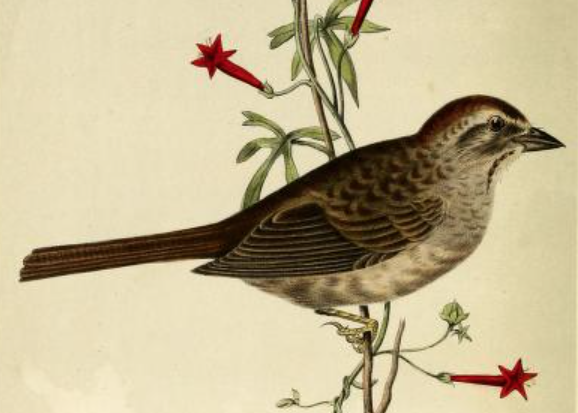
Original description: Ammodromus ruficeps Cassin 1852
Taxonomic history in AOU/AOS Check-list
AOU 1 (1886): Rufous-crowned Sparrow, Peucaea ruficeps; Boucard’s Sparrow, Peucaea ruficeps boucardi; Rock Sparrow, Peucaea ruficeps eremoeca
AOU 2 (1895): Rufous-crowned Sparrow, Peucaea ruficeps; Boucard’s Sparrow, Peucaea ruficepsboucardi; Rock Sparrow, Peucaea ruficepseremoeca
AOU 3 (1910): Rufous-crowned Sparrow, Aimophila ruficeps ruficeps; Scott’s Sparrow, Aimophila ruficeps scotti; Rock Sparrow, Aimophila ruficeps eremoeca; Laguna Sparrow, Aimophila ruficeps sororia
AOU 4 (1931): Rufous-crowned Sparrow, Aimophila ruficeps ruficeps; Santa Cruz Sparrow, Aimophila ruficeps obscura; Ashy Sparrow, Aimophila ruficeps canescens; Cape Colnett Sparrow, Aimophila ruficeps lambi; Laguna Sparrow, Aimophila ruficeps sororia; Rock Sparrow, Aimophila ruficeps eremoeca; Scott’s Sparrow, Aimophila ruficeps scotti
AOU 5 (1957): Rufous-crowned Sparrow, Aimophila ruficeps eremoeca, Aimophila ruficeps scottii, Aimophila ruficeps rupicola, Aimophila ruficeps ruficeps, Aimophila ruficeps obscura, Aimophila ruficeps canescens, Aimophila ruficeps sanctorum, Aimophila ruficeps sororia
AOU 6 (1983): Rufous-crowned Sparrow, Aimophila ruficeps
AOU 7 (1998): Rufous-crowned Sparrow, Aimophila ruficeps
IUCN Conservation Status: Of least concern
Of the four subspecies of the Rufous-crowned Sparrow that occur in California, one, obscura, the Santa Cruz Island Rufous-crowned Sparrow, is listed as a species of special concern in the state. This bird occurs only on Anacapa and Santa Cruz Islands; older records from Santa Rosa and Santa Catalina Islands are now considered questionable.
The chief threat to the subspecies has been the loss and degradation of suitable habitat. Introduced herbivores destroy the vegetative structure required by nesting birds, and the lack of cover probably increases nesting birds’ susceptibility to predation by native and introduced predators. Conversely, the systematic suppression of fire on the islands leads to excessively dense chaparall and ultimately abandonment of those habitats.
Feral cats and house rats were removed from the Anacapas early this century, and feral sheep were eliminated from Santa Cruz by 1984. The Rufous-crowned Sparrow population appears to have increased in response to these management decisions, and is now considered common on Santa Cruz Island; it is probably also common on two of the three Anacapa islets.
Given this species’ patchy distribution throughout its range, local populations can be imperiled by development and agricultural use.
Behavior: The Rufous-crowned Sparrow is a generally wary bird—so much so, in fact, that early reports of birds described as “quite tame and familiar, coming to feed on grain and crumbs daily about” city houses and outbuildings can be presumed to refer to Chipping Sparrows or another superficially similar species. Feeding birds, often in pairs or apparent family groups, quietly shuffle and scratch on rocky slopes, hopping steadily uphill and away from the observer, flying only when pressed too close. Like some other scrub and chaparral species, Rufous-crowned Sparrows sometimes seem reluctant to fly downslope away from distrubance, making them sometimes easier to watch from a point above them.
Classic ground birds, Rufous-crowned Sparrows also feed in low, open bushes such as manzanita. On occasion, they ascend to mid-heights in blossoming cottonwoods and willows along desert washes, where they take insects from bark and buds.
The flight of this species is usually heavy and slow, the short wings, long tail, and general lack of aerial control recalling the larger Canyon Towhee. Flying birds are almost always silent.
Males sing from slightly elevated perches, from rocks to bush tops. They may also sing from the ground while feeding, and, less frequently, in short, clumsy song flights.
Voice: The most characteristic and easily recognized of the Rufous-crowned Sparrow’s vocalizations is the famous nasal “dear, dear” call, given singly or in an irregular series; given more often by males, it “is thought to convey mild alertness to danger.” Pairs maintain contact with a soft, slurred dzeep, and also have a “reunion duet” analogous to that of the brown towhees. Agitated birds frequently give a loose, liquid chatter, similar to the rattle contributed by the female to the reunion duet.
Once learned, the singing of the Rufous-crowned Sparrow becomes a characteristic spring and summer sound of rocky hillsides in southwestern North America. Typical songs are rather quiet but sustained, a series of rapidly delivered chips and lisps like a handful of tiny pebbles tossed down the slope. The song is often compared to that of northern House Wrens, sharing its wide pitch range and chattering quality, but higher-pitched and less musical; the frequent doubling of notes may distantly recall the song of the Indigo Bunting. An infrequent variant concludes with a long trill.
Detailed description and measurements drawn from standard reference works
Adult Aimophila ruficeps scottii: Tail feathers brown with dull rufous edges. Upper tail coverts and rump pale brownish tinged grayish; feathers of back and scapulars faintly edged page gray. Variably but generally obscurely streaked chestnut-brown on back; pale edgings create vaguely mottled appearance. Primaries and secondaries dull brownish chestnut with hint of grayer edging; tertials dull brownish chestnut with poorly defined dark gray edging. Greater and median coverts grayish chestnut with grayer edges; median coverts and inner greater coverts with large sooty centers. Nape grayish on sides, scaled, flecked, or solid rufous in center.
Underparts pale gray-brown, palest on belly. Throat pale whitish, separated from wide, pale whitish jaw stripe by complete and well-defined black lateral throat stripe. Crown pale rufous with indistinct light gray feather edgings forming faint streaks. Ear coverts and broad supercilium pale gray, shading to very pale whitish above lore. Rusty eye line interrupts broad white eye ring at rear of eye. Lore mottled blackish.
Short, stout tarsi and toes pale brownish pink.
Juvenile: upperparts messily streaked reddish brown and gray. Ashy gray beneath with scattered narrow black streaking, heaviest on breast. Breast, breast sides, flanks, and under tail coverts with light tawny overlay. Crown dull brown with faint darker brown streaking. Lateral throat stripe brown, and poorly defined or absent.
Short, stout tarsi and toes pale brownish.
Length 135-155 mm (5.3-6.1 inches)
Wing chord 60-70 mm (2.4-2.8 inches)
Tail 64-74 mm (2.5-2.9 inches)
W:T 0.93
Mass 17-20

